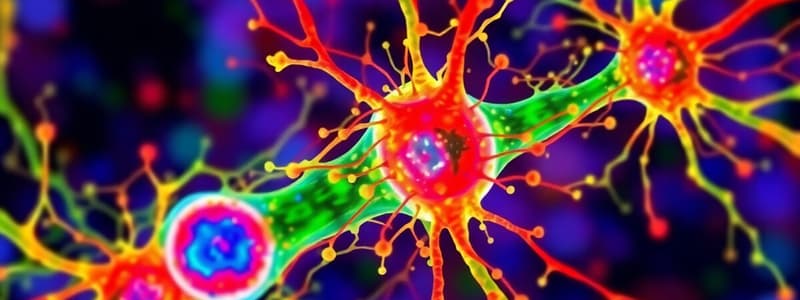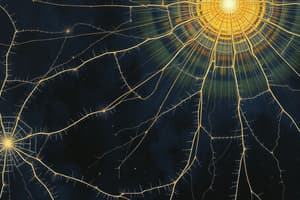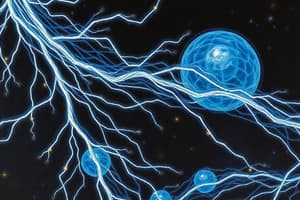Podcast
Questions and Answers
What role do microfilaments play in intestinal epithelial cells?
What role do microfilaments play in intestinal epithelial cells?
- Serve as storage for cellular nutrients
- Facilitate cell motility through contraction
- Support the structure of the plasma membrane
- Make up the core of microvilli (correct)
How do actin-myosin interactions contribute to muscle cells?
How do actin-myosin interactions contribute to muscle cells?
- Enhance the stability of the cell membrane
- Increase cellular permeability to nutrients
- Mediate the contraction of muscle cells (correct)
- Facilitate DNA replication
What defines pseudopodia in amoeba?
What defines pseudopodia in amoeba?
- Permanent extensions for nutrient storage
- Transient structures for locomotion (correct)
- Rigid appendages for defense
- Fixed structures for shape maintaining
Which of the following is NOT a function of microfilaments?
Which of the following is NOT a function of microfilaments?
In muscle cells, which process is primarily driven by the actin-myosin contractile system?
In muscle cells, which process is primarily driven by the actin-myosin contractile system?
What is the primary function of dynein in the context of microtubules?
What is the primary function of dynein in the context of microtubules?
Which statement regarding kinesin is correct?
Which statement regarding kinesin is correct?
What type of motor protein is responsible for transport toward the plus end of the microtubule?
What type of motor protein is responsible for transport toward the plus end of the microtubule?
In the context of cellular transport, what do motor proteins utilize to carry vesicles?
In the context of cellular transport, what do motor proteins utilize to carry vesicles?
What characteristic distinguishes the role of kinesin and dynein?
What characteristic distinguishes the role of kinesin and dynein?
What is the primary function of fibronectin within the extracellular matrix (ECM)?
What is the primary function of fibronectin within the extracellular matrix (ECM)?
Which collagen type is most abundant in the human body and is crucial for tissue structure?
Which collagen type is most abundant in the human body and is crucial for tissue structure?
What structural motif is characteristic of collagen's helical chains?
What structural motif is characteristic of collagen's helical chains?
Which collagen type is primarily found in cartilage?
Which collagen type is primarily found in cartilage?
Which syndrome is associated with reduced production of Type I collagen?
Which syndrome is associated with reduced production of Type I collagen?
What cells primarily produce collagen in the extracellular matrix?
What cells primarily produce collagen in the extracellular matrix?
Which type of collagen is associated with the basement membrane?
Which type of collagen is associated with the basement membrane?
What is the primary role of the basement membrane?
What is the primary role of the basement membrane?
What is a primary function of the plant cell wall?
What is a primary function of the plant cell wall?
Which of the following materials primarily composes plant cell walls?
Which of the following materials primarily composes plant cell walls?
What distinguishes plant cell walls from those of animal cells?
What distinguishes plant cell walls from those of animal cells?
Which statement about the cell wall is incorrect?
Which statement about the cell wall is incorrect?
Which of these components is found in prokaryotic cell walls, but not in plant cell walls?
Which of these components is found in prokaryotic cell walls, but not in plant cell walls?
What role does the plant cell wall play in regulating water uptake?
What role does the plant cell wall play in regulating water uptake?
Which organisms besides plants are known to possess cell walls?
Which organisms besides plants are known to possess cell walls?
What prevents plant cells from taking in too much water?
What prevents plant cells from taking in too much water?
What is the primary role of the centrosome in the cytoskeleton?
What is the primary role of the centrosome in the cytoskeleton?
Which of the following structures is a component of the cytoskeleton?
Which of the following structures is a component of the cytoskeleton?
What distinguishes flagella from cilia?
What distinguishes flagella from cilia?
Which of the following correctly describes microfilaments?
Which of the following correctly describes microfilaments?
What is a common extracellular component of animal cells?
What is a common extracellular component of animal cells?
Which type of junction is primarily responsible for the direct communication between animal cells?
Which type of junction is primarily responsible for the direct communication between animal cells?
How do plant cells typically connect with each other?
How do plant cells typically connect with each other?
Which statement about intermediate filaments is true?
Which statement about intermediate filaments is true?
Which motor protein primarily facilitates movement towards the cell periphery along microtubules?
Which motor protein primarily facilitates movement towards the cell periphery along microtubules?
What is the primary function of cilia in eukaryotic cells?
What is the primary function of cilia in eukaryotic cells?
Which statement accurately describes the motion of flagella?
Which statement accurately describes the motion of flagella?
Which of the following best describes the structure of cilia?
Which of the following best describes the structure of cilia?
What is a notable difference between flagella and cilia regarding their number per cell?
What is a notable difference between flagella and cilia regarding their number per cell?
What type of movement pattern do cilia use to propel the cell?
What type of movement pattern do cilia use to propel the cell?
Which end of a microtubule is typically associated with the forward motion of kinesin?
Which end of a microtubule is typically associated with the forward motion of kinesin?
Which type of cell structure would likely utilize dynein for its function?
Which type of cell structure would likely utilize dynein for its function?
Flashcards
Microtubules: Structure and Function
Microtubules: Structure and Function
Microtubules are long, hollow, cylindrical structures found in eukaryotic cells. They play a vital role in cell shape, movement and intracellular transport.
Motor Proteins: Motility
Motor Proteins: Motility
Motor proteins are responsible for moving cargo along microtubules. They have specific regions that bind to microtubules and to cargo.
Dynein: Retrograde Transport
Dynein: Retrograde Transport
Dynein is a motor protein that moves cargo from the cell periphery towards the cell center. It moves along microtubules in a retrograde direction, from the plus end to the minus end.
Kinesin: Anterograde Transport
Kinesin: Anterograde Transport
Signup and view all the flashcards
Vesicle Transport: Microtubule Highway
Vesicle Transport: Microtubule Highway
Signup and view all the flashcards
Cytoskeleton
Cytoskeleton
Signup and view all the flashcards
Microfilaments
Microfilaments
Signup and view all the flashcards
Microtubules
Microtubules
Signup and view all the flashcards
Intermediate Filaments
Intermediate Filaments
Signup and view all the flashcards
Centrosome
Centrosome
Signup and view all the flashcards
Cilia
Cilia
Signup and view all the flashcards
Flagella
Flagella
Signup and view all the flashcards
Extracellular Matrix
Extracellular Matrix
Signup and view all the flashcards
Plant Cell Wall
Plant Cell Wall
Signup and view all the flashcards
Cellulose
Cellulose
Signup and view all the flashcards
Plasmodesmata
Plasmodesmata
Signup and view all the flashcards
Primary Cell Wall
Primary Cell Wall
Signup and view all the flashcards
What is the function of microfilaments in intestinal microvilli?
What is the function of microfilaments in intestinal microvilli?
Signup and view all the flashcards
How do microfilaments contribute to cell motility?
How do microfilaments contribute to cell motility?
Signup and view all the flashcards
How does the actin-myosin contractile system contribute to muscle contraction?
How does the actin-myosin contractile system contribute to muscle contraction?
Signup and view all the flashcards
What are pseudopodia and their function in cell movement?
What are pseudopodia and their function in cell movement?
Signup and view all the flashcards
How do amoebas use microfilaments for movement and feeding?
How do amoebas use microfilaments for movement and feeding?
Signup and view all the flashcards
Microtubule Motor Proteins
Microtubule Motor Proteins
Signup and view all the flashcards
Cilia and Flagella
Cilia and Flagella
Signup and view all the flashcards
Flagella Motility Pattern
Flagella Motility Pattern
Signup and view all the flashcards
Cilia Motility Pattern
Cilia Motility Pattern
Signup and view all the flashcards
Plus (+) and Minus (-) Ends of Microtubules
Plus (+) and Minus (-) Ends of Microtubules
Signup and view all the flashcards
Extracellular Matrix (ECM)
Extracellular Matrix (ECM)
Signup and view all the flashcards
Integrins
Integrins
Signup and view all the flashcards
Collagen
Collagen
Signup and view all the flashcards
Basement Membrane (Basal Lamina)
Basement Membrane (Basal Lamina)
Signup and view all the flashcards
Fibronectin
Fibronectin
Signup and view all the flashcards
What is the medical condition associated with reduced production of Type I collagen?
What is the medical condition associated with reduced production of Type I collagen?
Signup and view all the flashcards
What medical condition is associated with deficiency of Type III collagen?
What medical condition is associated with deficiency of Type III collagen?
Signup and view all the flashcards
What condition is associated with defective Type IV collagen?
What condition is associated with defective Type IV collagen?
Signup and view all the flashcards
Study Notes
Cell Structure and Components
- The cytoskeleton is a network of filaments throughout the cytoplasm
- It is composed of three types of filaments:
- Microfilaments (actin filaments): the thinnest components
- Intermediate filaments: filaments with middle-range diameters, composed of different protein types (e.g., keratin)
- Microtubules: tubulin filaments, the thickest of the three components
- Cytoskeleton functions:
- Mechanical support for the cell
- Maintains cell shape
- Organizes cell structures and activities
- Allows cell movement
- Can be assembled and disassembled to change cell shape
Cytoskeleton: Microtubules
- Microtubules are hollow rods, the thickest component of the cytoskeleton
- They are helical polymers made of tubulin monomers
- Microtubule functions include:
- Mitotic spindle formation, separating chromosome copies in dividing cells
- Shaping the cell
- Guiding organelle movement
Microtubules: Centrosomes and Centrioles
- The centrosome is a microtubule-organizing center (MTOC)
- It consists of a centriole pair
- Located near the nucleus (cell center)
- Found only in animal cells
- Yeast and plant cells do not have centrosomes but may contain similar structures
- Centrosome structure: has 2 centrioles
- Centrioles are composed of nine triplets of microtubules (9+0 arrangement)
- Pericentriolar material surrounds the centrosome
- Contains y-tubulin that facilitates the nucleation of microtubules
Microtubules and Motility
- Microtubules act as "monorails" for the movement of vesicles, organelles, and chromosomes.
- Motor proteins (cytoplasmic motor proteins) move cargo along microtubules:
- Dynein: transports material from periphery towards cell center (+ to - end)
- Kinesin: transports materials from cell center toward periphery (- to + end)
Cilia and Flagella
- Cilia and flagella are permanent locomotor appendages of some eukaryotic cells
- They contain specialized arrangements of microtubules (9+2 arrangement of microtubules)
- Cilia move in back-and-forth motion
- Flagella move in a snakelike motion
- Axoneme: the central strand of cilia and flagella, composed of microtubules
- Axonemal dynein: responsible for bending movements of cilia and flagella
- Basal body: a protein structure found at the base of eukaryotic cilia and flagella, consists of nine triplets microtubules (9+0 arrangement)
Microfilaments (Actin Filaments)
- Microfilaments are solid rods, composed of two intertwined strands of actin
- Can be assembled and disassembled to change cell shape
- Act in muscle contraction
- Function in cell motility in organisms such as amoebas.
- Also responsible for microvilli core structures in the intestinal epithelial cells and cytoplasmic streaming processes.
Intermediate Filaments
- Intermediate filaments are larger than microfilaments but smaller than microtubules
- They are more permanent than microfilaments or microtubules
- Function: provide support to cell shape and fix organelles in place
- Intermediate filaments help make up desmosomes in epithelial cells
- Some examples of IF types include keratin, desmin, vimentin, neurofilaments, GFAP and lamins.
Extracellular Components
- Most animal cells are covered by the extracellular matrix (ECM)
- ECM consists of glycoproteins and proteoglycans
- Glycoproteins include collagen, fibronectin, and laminin
- Proteoglycans are proteins plus glycosaminoglycans
- ECM functions overall are to provide support, facilitate adhesion, cell movement, and regulate gene expression.
Plant Cell Walls
- Plant cell walls are found outside of the plasma membrane
- They are an extracellular structure distinct from animal cell walls
- Plant cell walls consist mostly of cellulose fibers embedded in other polysaccharides and proteins
- Functions of plant cell walls include: protection for the cell, maintaining its shape, and preventing excessive uptake of water.
Intercellular Junctions
- Intercellular junctions are important for cell coordination and communication
- Plant cells have plasmodesmata: channels that connect neighboring plant cells and allow the exchange of molecules
- Animal cells have tight junctions, desmosomes, and gap junctions.
- Tight junctions prevent intercellular leakage of fluid.
- Desmosomes fasten cells together into strong sheets.
- Gap junctions provide channels allowing ion and small molecule exchange.
Studying That Suits You
Use AI to generate personalized quizzes and flashcards to suit your learning preferences.




